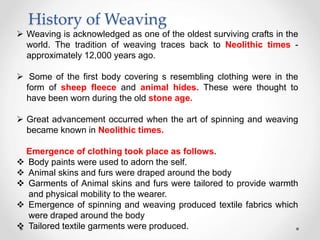Topic 1 History-of-Weaving-Power Point Presentation
Weaving, an intricate art of interlacing threads to produce fabric, stands as one of humanity's oldest and most foundational technologies. This paper delves into the rich tapestry of weaving's history, tracing its origins from the rudimentary hand-spun techniques of ancient civilizations to the sophisticated mechanized processes of the modern era. Through the ages, weaving has not only served as a means of producing clothing and shelter but has also held deep cultural, social, and economic significance. The narrative highlights key developments, innovations, and the global diffusion of weaving techniques, underscoring its pivotal role in shaping societies and fostering cross-cultural exchanges. Furthermore, this exploration touches upon the revival of traditional weaving practices in contemporary contexts, emphasizing the enduring legacy and relevance of this age-old craft in the contemporary world.

Recommended
Recommended
More Related Content
Similar to Topic 1 History-of-Weaving-Power Point Presentation
Similar to Topic 1 History-of-Weaving-Power Point Presentation (20)
Recently uploaded
Recently uploaded (20)
Topic 1 History-of-Weaving-Power Point Presentation
- 1. History of Weaving Weaving is acknowledged as one of the oldest surviving crafts in the world. The tradition of weaving traces back to Neolithic times - approximately 12,000 years ago. Some of the first body covering s resembling clothing were in the form of sheep fleece and animal hides. These were thought to have been worn during the old stone age. Great advancement occurred when the art of spinning and weaving became known in Neolithic times. Emergence of clothing took place as follows. Body paints were used to adorn the self. Animal skins and furs were draped around the body Garments of Animal skins and furs were tailored to provide warmth and physical mobility to the wearer. Emergence of spinning and weaving produced textile fabrics which were draped around the body Tailored textile garments were produced.
- 2. •In early civilization, people were nomads. •They needed homes that they knew would be temporary, but were still secure. •They used the resources they found in nature to weave what supplies they could. •They also wove walls, doors, rugs and hammocks. • Once people began to settle and clothing started being made for more than simply survival purposes, it began being created to •Show Power •Frighten the Enemy •Social Approval or Social Status
- 3. Even before the actual process of weaving was discovered, the basic principle of weaving was applied to interlace branches and twigs to create fences, shelters and baskets for protection. Humans used weaving to create baskets long before they used the process to make cloth. Early baskets were probably made by weaving grasses and plant materials around gourds to give them a useful shape.
- 4. The excavations at Harappa and Mohenjo-Daro reveal that the spinning wheel or the charkha was, bone needles and wooden spindles were essential part of the sub-continental household. It’s been found that fabric-making was an important part of people’s lives even at the time when the Indus Valley Civilization flourished. The Vedic Aryans and the Buddhists who settled in this region after the Indus Valley Civilization also used the charkha. The entire cloth-making process which was done by hand, involved great skill Due to nature’s hazards of erosion, climatic conditions, insects and fire, only few examples of early woven fabrics have survived. The everyday needs of our prehistoric ancestors probably led them to create objects using fibers as medium.
- 7. Ancient human instinctively used weaving as an aid in their quest for basic needs of food, shelter and clothing. The idea of weaving came in ancient human by observing spider’s web, birds nest, or a construction of beaver’s dam. Twining and braiding technique were also be used by primitive people to make mats to cover the floors of huts which helped in insulation against dampness or cold. Archeologists believe that basket making and weaving were probably the first “Crafts "developed by humans. Eventually people used weaving skills to make exterior coverings for shelters so that they would be somewhat protected from harsh weather or from predators.
- 10. During the Neolithic Era mankind developed great skill in weaving cloth. Every household produced cloth for their own needs. Weaving cloth remained an activity associated with the family unit for thousands of years. By the 11th century many of the weaving patterns used today had been invented.
- 11. THANK YOU